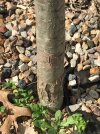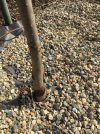You are using an out of date browser. It may not display this or other websites correctly.
You should upgrade or use an alternative browser.
You should upgrade or use an alternative browser.
The Woods ... mistakes I'v made
- Thread starter OakSeeds
- Start date
GoldenTriangleIL
5 year old buck +
For the expert TSI/FSI folks. I girdled a tree yesterday and I am wondering if there is a way to save the tree as I am having second thoughts. I usually spray my single girdle cuts with a herbicide cocktail but I didn't spray this tree. It is a swamp white oak. Anyone have any strategies?
Bill
Administrator
For the expert TSI/FSI folks. I girdled a tree yesterday and I am wondering if there is a way to save the tree as I am having second thoughts. I usually spray my single girdle cuts with a herbicide cocktail but I didn't spray this tree. It is a swamp white oak. Anyone have any strategies?
I’d say there’s nothing you can do at this point.
Kinda like Shooting one smaller than you’d hoped. Never look at a buck through a scope if you haven’t decided to kill it. Same with the saw.
GT ... if you cut the cambium deeply all around the trunk, it's not likely the tree will survive - as Bill noted. However, depending how big the girdle is, you have nothing to lose by keeping the tree (don't cut it down) and you might try the following ... fill the cut area with spong-calk-rope and then cover rope with a cheap calk to keep the rope in place (the calk keeps birds or other critters from stealing the rope for nesting purposes) while the rope calk will keep out disease carrying insects and excess moisture or air that would inhibit recovery. Maybe a little shot of 10-10-10 this spring. I have no idea if this will save the tree; however, if you have serious second thoughts about wanting to save the tree, I'd give it until summer 2022 to exhibit signs of survival/early recovery. Good luck my friend.
P.S. Upon reading your post a second time I note you refer to a "single girdle cut'" If that means you took only one little/big whack down the trunk, it is more likely the tree will repair the wound-damage over time. If that is the case and no chemicals were applied, I'd still cover the wound to keep diseasae-carrying insects from gaining an entry point.
Attached is a photo of a white oak that was deeply girdled around the entire tree that recovered fully (took over 2 years).
P.S. Upon reading your post a second time I note you refer to a "single girdle cut'" If that means you took only one little/big whack down the trunk, it is more likely the tree will repair the wound-damage over time. If that is the case and no chemicals were applied, I'd still cover the wound to keep diseasae-carrying insects from gaining an entry point.
Attached is a photo of a white oak that was deeply girdled around the entire tree that recovered fully (took over 2 years).
Attachments
Last edited:
GoldenTriangleIL
5 year old buck +
I made a single cut around the entire tree. It is leaning at 45 degrees and partially blocking a bur oak I was releasing. It is a very large tree. We’ll see what happens. Thanks for feedback.GT ... if you cut the cambium deeply all around the trunk, it's not likely the tree will survive - as Bill noted. However, depending how big the girdle is, you have nothing to lose by keeping the tree (don't cut it down) and you might try the following ... fill the cut area with spong-calk-rope and then cover rope with a cheap calk to keep the rope in place (the calk keeps birds or other critters from stealing the rope for nesting purposes) while the rope calk will keep out disease carrying insects and excess moisture or air that would inhibit recovery. Maybe a little shot of 10-10-10 this spring. I have no idea if this will save the tree; however, if you have serious second thoughts about wanting to save the tree, I'd give it until summer 2022 to exhibit signs of survival/early recovery. Good luck my friend.
P.S. Upon reading your post a second time I note you refer to a "single girdle cut'" If that means you took only one little/big whack down the trunk, it is more likely the tree will repair the wound-damage over time. If that is the case and no chemicals were applied, I'd still cover the wound to keep diseasae-carrying insects from gaining an entry point.
Attached is a photo of a white oak that was deeply girdled around the entire tree that recovered fully (took over 2 years).
et .... first, I rarely use a water pipe on a conifer ... I just throw a handful of 12-12-12 under the tree and in the mulch covering the root zone. For oaks, persimmons, pears, and chestnuts, in the early spring - with cool temps - when the frost is first out of the ground and it's really soggy, I don't put much fertilizer in the pipe. Since I use primarily water soluble fertilizers that will leach out after 3-4 inches of rain, I try to catch a day when rain is very likely (I'll be fertilizing tomorrow in the mid-West) and distribute water-based fertilizer on top of the ground around the root zone of each tree. This provides wider dispersal of the fertilizer quickly for a fast pick-up by much of the root structure and with light rain forecast in my area for the next 2 days, it is a great time for early fertilizer. I use my water pipes more in the hotter/drier/windy part of early summer when I want to ensure efficient delivery of fertilizer to the root zone. I have fed trees as late as Aug. 10 with very little apparent freeze damage, but I try to end tree fertilization by June 15/July 1. Water pipes are especially useful in the late summer when it's more likely to be extremely hot and dry; providing water (no fertilizer) efficiently (directly into the root zone) is very beneficial for growth.
Good luck to you; please give me a shout if I can be of help.
A lot of folks like slow release fertilizer with urea that - when placed on the ground in the root zone - provide fertilization whenever it rains or water is distributed on the fertilizer.
My neighbor, who is a chemist, says all mammals have urea in their urine. Don't know the effect of taking a leak on the root zone of one of your trees.
Good luck to you; please give me a shout if I can be of help.
A lot of folks like slow release fertilizer with urea that - when placed on the ground in the root zone - provide fertilization whenever it rains or water is distributed on the fertilizer.
My neighbor, who is a chemist, says all mammals have urea in their urine. Don't know the effect of taking a leak on the root zone of one of your trees.
Last edited:
Definitely, I would mix it .... what I use - e.g., oaks - is in concentrated, granular form (Schultz is 32-10-10) and only a small amount is needed to fertilize a single tree; very difficult to apply efficiently as granuals in order to achieve widespread coverage.
Attachments
you are welcome; always happy to try and be of asasistanceThanks oaks. You helped tremendously.
Knehrke
5 year old buck +
I had help on Sunday, so I tried to make some progress on dropping the dying Ash that are close enough to our trails to become an issue, particularly if they attract poison ivy once defoliated. The first thirty or so trees fell perfectly. The thirty-first, though - well, let's just say that we hadn't realized how much the wind had picked up. One of my five year old oaks suffered greatly for our mistake. Eventually, the winds got up to 40 mph, but we were done after that one lol.
And the last two evenings have been solid picking up of tubes - perhaps the biggest mistake I made owning this land (so far). 3' tubes on shrubs just give the deer a visual cue, and whatever emerges gets chomped immediately. I hope that after three or four years in the ground, the root systems have developed enough to allow the shrubs to grow once the tube stop attracting deer. Or maybe the deer will eat them now since they're not protected, right to the ground. Either way, I've managed to remove ~700 tubes over the past few evenings, hauling them and their stakes to a roll-off dumpster that a buddy of mine got for me at the front of the property. When I think of the effort that we spent, I just shake my head.
The moral of the story is that friends shouldn't let friends do tubes.
And the last two evenings have been solid picking up of tubes - perhaps the biggest mistake I made owning this land (so far). 3' tubes on shrubs just give the deer a visual cue, and whatever emerges gets chomped immediately. I hope that after three or four years in the ground, the root systems have developed enough to allow the shrubs to grow once the tube stop attracting deer. Or maybe the deer will eat them now since they're not protected, right to the ground. Either way, I've managed to remove ~700 tubes over the past few evenings, hauling them and their stakes to a roll-off dumpster that a buddy of mine got for me at the front of the property. When I think of the effort that we spent, I just shake my head.
The moral of the story is that friends shouldn't let friends do tubes.
Troubles Trees
5 year old buck +
Are you really throwing the 3' tubes away? You are roughly 2 hours away from me according to Google Maps, you might find someone dumpster-diving this weekend! lol I have 130 Oak acorns to plant this spring and was contemplating how I was going to protect them from squirrels for the first year.I had help on Sunday, so I tried to make some progress on dropping the dying Ash that are close enough to our trails to become an issue, particularly if they attract poison ivy once defoliated. The first thirty or so trees fell perfectly. The thirty-first, though - well, let's just say that we hadn't realized how much the wind had picked up. One of my five year old oaks suffered greatly for our mistake. Eventually, the winds got up to 40 mph, but we were done after that one lol.
And the last two evenings have been solid picking up of tubes - perhaps the biggest mistake I made owning this land (so far). 3' tubes on shrubs just give the deer a visual cue, and whatever emerges gets chomped immediately. I hope that after three or four years in the ground, the root systems have developed enough to allow the shrubs to grow once the tube stop attracting deer. Or maybe the deer will eat them now since they're not protected, right to the ground. Either way, I've managed to remove ~700 tubes over the past few evenings, hauling them and their stakes to a roll-off dumpster that a buddy of mine got for me at the front of the property. When I think of the effort that we spent, I just shake my head.
The moral of the story is that friends shouldn't let friends do tubes.
Awkward question but I will ask, would you mind if I came and got some out of the dumpster this weekend?
It's great to see people sharing information or resources like tubes or grow pots (saw on another thread). I'm not a tube fan (cages for everything); however, I have found a use for them I thought I'd share. A friend recently gave me 3, 5-footers and told me to try them with some plum starts. Didn't look to me like they were going to work very well with plums .... so, I used them as trunk protectors on some 3-4" dia oak trees. Obviously, they are used to protect seedlings/whips, etc, but I was installing them on 10-yr old trees. I slit them lengthwise and wrapped them around each tree; fastened each loosely with 2 zip-ties.
I deal with a high deer count with some aggressive bucks; I think some batter 4-5' woven-wire cages as a conditioning exercise. Much to my surprise and delight, not one of the "tubed" oak-tree trunks was attacked. I now -tentatively - (going to add 5-6 more and and check the results next March) accept tubes as a valuable trunk-protector tool in my habitat toolbox. Perhaps anything that prevents antlers from touching bark is a sufficient deterrent(?).
I deal with a high deer count with some aggressive bucks; I think some batter 4-5' woven-wire cages as a conditioning exercise. Much to my surprise and delight, not one of the "tubed" oak-tree trunks was attacked. I now -tentatively - (going to add 5-6 more and and check the results next March) accept tubes as a valuable trunk-protector tool in my habitat toolbox. Perhaps anything that prevents antlers from touching bark is a sufficient deterrent(?).
rocksnstumps
5 year old buck +
Tubes: lotta opinions just like most advice, but can't resist.
Agree any tube under 5 ft tall has limited value when deer want to eat what is inside.
One and done mentality with tubes is a pipe dream. They take maintenance to clean out, prune inside, etc
Slitting tubes and using as truck protectors. I have done that sometimes in fall and winter when I run short of cages and rotating certain trees like oaks outta tubes. Usually the tube clings to the tree without any fasteners. But pull them off and protect better in the warmer months because that plastic right next to bark traps moisture and bark can get funky/mold/moss nastiness. However that slick plastic does seem to deter better than just wrapping with window screen for instance.
Agree any tube under 5 ft tall has limited value when deer want to eat what is inside.
One and done mentality with tubes is a pipe dream. They take maintenance to clean out, prune inside, etc
Slitting tubes and using as truck protectors. I have done that sometimes in fall and winter when I run short of cages and rotating certain trees like oaks outta tubes. Usually the tube clings to the tree without any fasteners. But pull them off and protect better in the warmer months because that plastic right next to bark traps moisture and bark can get funky/mold/moss nastiness. However that slick plastic does seem to deter better than just wrapping with window screen for instance.
Knehrke
5 year old buck +
Great intel. I have so many 5' tubes that it should be easy to save a bunch for winter month protection from the many where rodents, deer, or nature got the contents.
TT, you are welcome to any of the 3' tubes you want, but they are on their second life already - I bought them used, and the metal stakes are mostly rotted now too. If I were you, I'd take a hard pass. I never used them to plant nuts, but only first year stems I'd grown from nuts. They are fairly brittle now. I shot you a pm with my cell if you're serious though.
TT, you are welcome to any of the 3' tubes you want, but they are on their second life already - I bought them used, and the metal stakes are mostly rotted now too. If I were you, I'd take a hard pass. I never used them to plant nuts, but only first year stems I'd grown from nuts. They are fairly brittle now. I shot you a pm with my cell if you're serious though.
Troubles Trees
5 year old buck +
Good man Knerke! I messaged you back bud, I will swing by tomorrow and grab a bunch!Great intel. I have so many 5' tubes that it should be easy to save a bunch for winter month protection from the many where rodents, deer, or nature got the contents.
TT, you are welcome to any of the 3' tubes you want, but they are on their second life already - I bought them used, and the metal stakes are mostly rotted now too. If I were you, I'd take a hard pass. I never used them to plant nuts, but only first year stems I'd grown from nuts. They are fairly brittle now. I shot you a pm with my cell if you're serious though.
Can't thank you enough bud!
Similar threads
- Replies
- 16
- Views
- 2K



